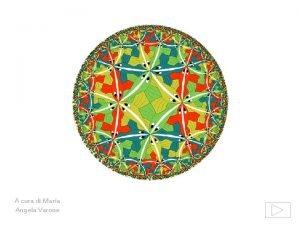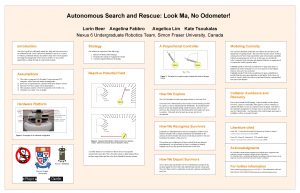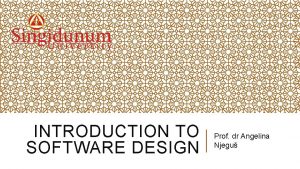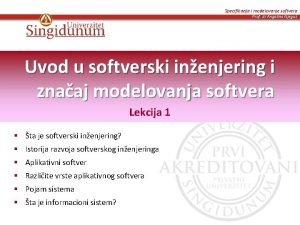Software Architecture PROF DR ANGELINA NJEGU System Analysis



















- Slides: 19

Software Architecture PROF. DR ANGELINA NJEGUŠ

System Analysis vs System Design Systems Analysis: development phases in a project that primarily focus on the business problems WHAT the system must do in terms of Data, Processes, and Interfaces, independent of any technology that can or will be used to implement a solution to that problem. Systems Design: development phases focus on the technical construction and implementation of the system HOW technology will be used in the system.

System Analysis phases § Software Architecture § Sequence diagram/ Communication diagram § Class diagram

Software Architecture defined IEEE 1471 -2000 ◦ Software architecture is the fundamental organization of a system, embodied in its components, their relationships to each other and the environment, and the principles governing its design and evolution

Why is architecture important? § Handling complexity § Communication among stakeholders § Early Design Decisions § SA is a transferable, reusable model

Architecture Drives Architecture serves as the blueprint for the system but also the project: ◦ ◦ ◦ Team structure Documentation organization Work breakdown structure Scheduling, planning, budgeting Unit testing, integration Architecture establishes the communication and coordination mechanisms among components

Models

Architectural patterns An architectural pattern is a general, reusable solution to a commonly occurring problem in software architecture within a given context.

1. Layered pattern The most commonly found 4 layers of a general information system are as follows. § § Presentation layer (also known as UI layer) Application layer (also known as service layer) Business logic layer (also known as domain layer) Data access layer (also known as persistence layer) Usage § General desktop applications § E commerce web applications

2. Client-server pattern This pattern consists of two parties: a server and multiple clients. ◦ The server component will provide services to multiple client components. ◦ Clients request services from the server and the server provides relevant services to those clients. ◦ The server continues to listen to client requests. Usage ◦ Online applications such as email, document sharing and banking.

3. Master-slave pattern This pattern consists of two parties: master and slaves. ◦ The master component distributes the work among identical slave components, and computes a final result from the results which the slaves return. Usage ◦ In database replication, the master database is regarded as the authoritative source, and the slave databases are synchronized to it. ◦ Peripherals connected to a bus in a computer system (master and slave drives).

4. Pipe-filter pattern This pattern can be used to structure systems which produce and process a stream of data. ◦ Each processing step is enclosed within a filter component. ◦ Data to be processed is passed through pipes. ◦ These pipes can be used for buffering or for synchronization purposes. Usage ◦ Compilers. ◦ The consecutive filters perform lexical analysis, parsing, semantic analysis, and code generation. ◦ Workflows in bioinformatics.

5. Broker pattern This pattern is used to structure distributed systems with decoupled components. ◦ These components can interact with each other by remote service invocations. ◦ A broker component is responsible for the coordination of communication among components. ◦ Servers publish their capabilities (services and characteristics) to a broker. Clients request a service from the broker, and the broker then redirects the client to a suitable service from its registry. Usage ◦ Message broker software such as Apache Active. MQ, Apache Kafka, Rabbit. MQ and JBoss Messaging.

6. Peer-to-peer pattern In this pattern, individual components are known as peers. ◦ Peers may function both as a client, requesting services from other peers, and as a server, providing services to other peers. ◦ A peer may act as a client or as a server or as both, and it can change its role dynamically with time. Usage ◦ File-sharing networks such as Gnutella and G 2. ◦ Multimedia protocols such as P 2 PTV and PDTP.

7. Event-bus pattern This pattern primarily deals with events and has 4 major components: event source, event listener, channel and event bus. ◦ Sources publish messages to particular channels on an event bus. ◦ Listeners subscribe to particular channels. ◦ Listeners are notified of messages that are published to a channel to which they have subscribed before. Usage ◦ Android development ◦ Notification services

8. Model-view-controller pattern This pattern, also known as MVC pattern, divides an interactive application in to 3 parts as: ◦ model — contains the core functionality and data ◦ view — displays the information to the user (more than one view may be defined) ◦ controller — handles the input from the user Usage ◦ Architecture for World Wide Web applications in major programming languages. ◦ Web frameworks such as Django and Rails.

Example of Android architecture

Which type of layer is this:

Which type of architecture this sequence diagram presents?
 Architecture business cycle activities
Architecture business cycle activities Call and return architecture in software architecture
Call and return architecture in software architecture Rettore università di ferrara
Rettore università di ferrara Canva.com
Canva.com Brad pitt shrek
Brad pitt shrek Angelina njegus
Angelina njegus Angelina jolie born
Angelina jolie born Angela varone
Angela varone Angelina lu
Angelina lu Aristides de sousa mendes angelina ribeiro
Aristides de sousa mendes angelina ribeiro Unset message angelina
Unset message angelina Angelina daniel
Angelina daniel Angelina baiden amissah
Angelina baiden amissah Angelina jolie golden ratio
Angelina jolie golden ratio Donna angelina
Donna angelina Angelina fabbro
Angelina fabbro Angelina njegus
Angelina njegus Angelina njegus
Angelina njegus Servisno orijentisana arhitektura
Servisno orijentisana arhitektura Angelina pillai
Angelina pillai


































